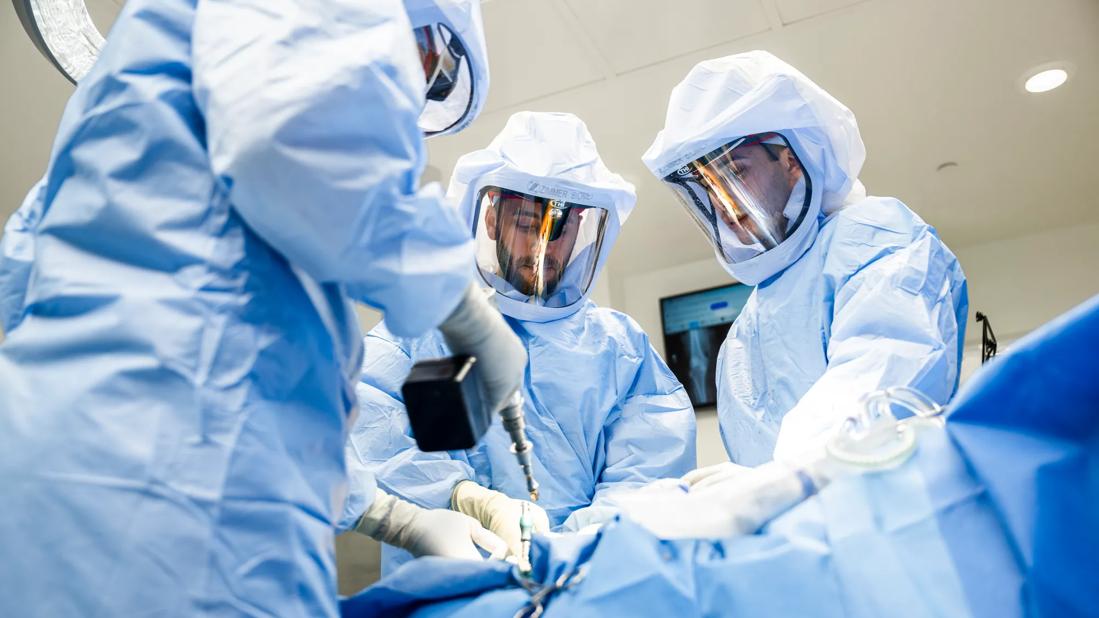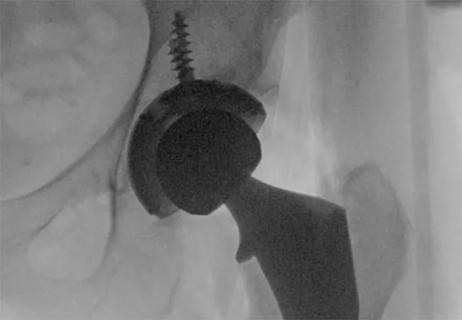For patients with anatomic abnormalities, substantial bone loss and pre-existing hardware

By Peter Surace, MD, and Michael Bloomfield, MD
Advertisement
Cleveland Clinic is a non-profit academic medical center. Advertising on our site helps support our mission. We do not endorse non-Cleveland Clinic products or services. Policy
The difference between a hip replacement that is successful and one that has complications may be millimeters, due to inaccuracies in size and position.
Many tools have been developed to help surgeons improve precision in total hip arthroplasty. For example, the use of robotics has helped reduce leg length discrepancy, improve implant position and increase postoperative stability.
While robotic guidance has proven beneficial in standard joint replacement, at Cleveland Clinic we also are using it off-label for complex hip reconstructions, including in patients with:
In these situations, the stakes are higher, the risk of complication is elevated, and getting a prosthesis in the right position is more challenging.
When patients have had previous acetabular fractures treated with open reduction and internal fixation, or plates and screws, we now use the robot to successfully plan a hip replacement around the implanted hardware. This can help us avoid a more invasive procedure required to remove the hardware. Using CT-based templating, we know ahead of time whether we can work around these implants or must plan to remove them.
In patients who had childhood or adolescent surgeries and now have either retained implants or substantial changes to their anatomy, we can plan the surgery three-dimensionally on the robotic platform. This helps us achieve a precise hip replacement without risks that otherwise could present.
Advertisement
In other cases, where the anatomy is so distorted, planning the surgery entirely on the robotic platform informs us if we will need certain additional implants. We know ahead of time when we need less commonly used sizes or models of implants and even tools such as acetabular augments. Rather than “finding out as we go” during surgery, we can carefully plan the procedure and execute it more methodically.
As a result, preparations for surgery are better and the potential for surprises during more complex procedures is minimized. By using the robot, complex surgeries (as in the three cases below) are becoming more routine and standardized — and, thus, we believe better and safer for the patient.
A chronic acetabular fracture was treated nonoperatively at another hospital and, over time, developed into a substantial deformity. The entire hip shifted medially, causing a severe discrepancy in leg length.
With conventional hip replacement, it would have been difficult to plan the exact size of the socket and ensure its lateral positioning, where the center of rotation belongs. However, with the robotic platform, we were able to plan removal of the hip easily, navigate our screw trajectory and achieve an outstanding press-fit with minimal difficulty.



A patient had an infected total hip that had been removed. An antibiotic spacer was placed, leaving the patient functionally without a hip. They had extreme leg length discrepancy and substantial bone loss.
We used the robotic platform to reproduce the anatomy with extreme precision, matching it to the native hip. This alleviated much of the guesswork and inaccuracy inherent in difficult cases like this.
Advertisement


This patient had bilateral hemi-resurfacing arthroplasties in the remote past for avascular necrosis. The patient presented with severe groin pain due to acetabular chondral wear.
Use of off-label robotic assistance (with metal artifact reduction CT) helped us accurately plan reconstruction in the setting of retained hardware and achieve excellent acetabular registration.


In summary, robotic hip replacement has proven successful in straightforward cases. At Cleveland Clinic, where we see a substantial number of highly complex reconstructions, we now are using robotic systems to provide more efficient, accurate and easier care for patients with larger problems and a higher risk of complication.
Drs. Surace and Bloomfield are staff physicians in the Department of Orthopaedic Surgery at Cleveland Clinic.
Advertisement
Advertisement

Multidisciplinary care can make arthroplasty a safe option even for patients with low ejection fraction

High-risk procedure prepares patient for lifesaving heart surgery

Cleveland Clinic is among the first in the U.S. to perform the procedure

Insights to help orthopaedic practices comply with the 2025 CMS mandate

Dr. Piuzzi wins 2025 Kappa Delta Young Investigator Award for pioneering work

How it actually compares to posterior and lateral approaches

Offers adequate exposure of normal and abnormal anatomy

Custom components offer better outcomes when conventional options fail